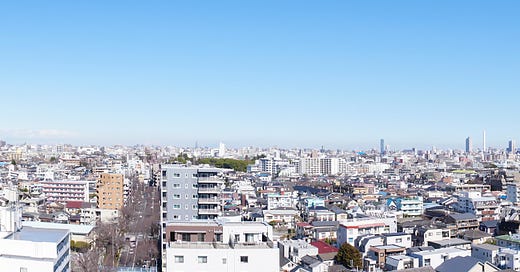Gentrification, Governance, and the Ambivalent Future of Tokyo
Rethinking Foreign Capital and Housing Constraint in Post-Pandemic Japan
Gearoid Reidy’s recent Bloomberg op-ed draws attention to the rapid increase in Tokyo real estate prices since the COVID-19 pandemic, especially in the city’s most central wards. His diagnosis—that foreign capital is playing an outsized role in the city’s current housing pressures—is not without merit. However, it obscures more than it reveals. While Japan’s property system is indeed permissive toward non-resident buyers—there are no additional taxes, no residency requirements, no restrictions on second-home ownership—the decisive control mechanism remains the domestic mortgage regime. Without local employment or substantial collateral, non-residents cannot secure loans. In effect, the very openness that Reidy identifies is regulated not by ownership law but by the conservative lending practices of Japanese banks.
That distinction matters. The claim that 20 to 40 percent of new units in central Tokyo are being sold to foreigners is not grounded in publicly verifiable data. The government does not systematically track the nationality of property buyers, a gap that renders such estimates speculative at best. Politically, the ambiguity is useful—it allows actors across the ideological spectrum to invoke the specter of foreign speculation while avoiding deeper structural diagnosis. Analytically, however, it invites caution. The wide range itself betrays a lack of precision, and the absence of disaggregated transaction data makes it difficult to distinguish between anecdotal distortions and sustained market trends.
The neighborhood near to Itabashi Station—a historically working- and middle-class ward on the northwest edge of the Yamanote loop—offers an instructive example. By 2020, it was already in the early stages of gentrification. Rent inflation was pronounced for newly constructed units and large apartments, but older stock—especially the standard 53-square-meter two-bedroom units—remained stagnant. Even when renovated, these units could not compete with the new builds in design, insulation, or desirability. They were not desirable assets for foreign capital, nor were they attractive to upwardly mobile domestic buyers.
The nature of new construction also merits attention. The post-2015 build cycle in Itabashi and similar wards has been dominated by 30-plus-story corporate developments. Gone are the six- to ten-story luxury apartments that catered to affluent domestic families in the 1980s and early 1990s. Part of the shift is aesthetic and institutional, but much of it is spatial. To construct at 30-story scale, a developer must consolidate the footprint of eight to ten adjacent properties. Given the fragmented ownership patterns and the persistence of small-scale landlords, such consolidations are difficult to achieve. The result is a lumpy geography of transformation: hyper-dense towers punctuate blocks of aging low-rise stock, but the latter persist, not from preservationist intent but because they resist financial consolidation.
Reidy briefly references the boom in rural property sales to foreigners, particularly the so-called akiya—abandoned houses in depopulated villages. These transactions are often framed as solutions to Japan’s demographic crisis, but they are structurally marginal. Most akiya are poorly insulated, socially isolated, and logistically distant from employment or services. They function more as symbolic gestures of revitalization than as meaningful interventions in the housing economy. Their popularity among foreign buyers reveals more about the fantasy of inhabiting a forgotten Japan than about alleviating urban housing pressure.
Tokyo’s current housing crisis, to the extent one can call it that, stems less from foreign acquisition and more from a mismatch between constrained supply and latent demand. Redevelopment has been aggressive in the urban core, but new supply remains spatially selective and demographically narrow. The rise of the dual-income “power couple” has redefined market demand, especially for high-amenity, centrally located properties. Yet the financial and infrastructural systems that sustain development remain slow, conservative, and resistant to major recalibration. Foreign capital may aggravate this imbalance at the margins, but it is not the structural driver.
What Reidy’s piece ultimately reflects is the ambivalence of Tokyo’s global future. On one hand, it is a city increasingly attractive to transnational capital and elite mobility. On the other, it remains governed by institutions—municipal, financial, infrastructural—that operate at a markedly different tempo. That friction is productive, but also unstable. If left unexamined, it will continue to surface as vague anxiety over foreign buyers rather than as a sustained debate about equity, planning, and the shape of urban life.
References
Tokyo Kantei Co. (2025) Tokyo Condominium Market Trends. [online] Available at: https://www.kantei.ne.jp/ [Accessed 27 May 2025].
Ministry of Land, Infrastructure, Transport and Tourism (MLIT) (2024) White Paper on Land, Infrastructure, Transport and Tourism in Japan, 2023. Tokyo: MLIT. Available at: https://www.mlit.go.jp/english/white-paper/index.html [Accessed 30 May 2025].
Reidy, G. (2025) ‘It’s Too Easy for Foreigners to Buy Property in Japan’, Bloomberg Opinion, 26 May. Available at: https://www.bloomberg.com/opinion/articles/2025-05-26/it-s-too-easy-for-foreigners-to-buy-property-in-japan [Accessed 27 May 2025].
Statistics Bureau of Japan (2024) Housing and Land Survey 2023. Tokyo: Ministry of Internal Affairs and Communications. Available at: https://www.stat.go.jp/english/data/jyutaku/2023/index.html [Accessed 20 May 2025].




